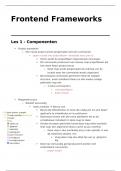Resumen
Summary Business Intelligence & Business Analytics (2023) - ALL reading material & ALL lectures
- Grado
- Institución
- Book
This document contains all reading material and lectures that were discussed during the lectures of Business Intelligence & Business Analytics in the spring of 2023. Note that the last Python exercises are not added in this summary! Full list of material: - Database systems: design, impleme...
[Mostrar más]





